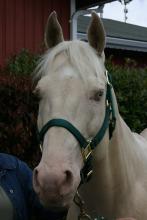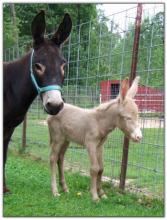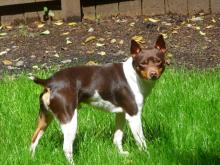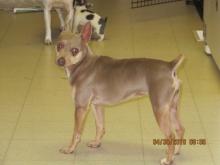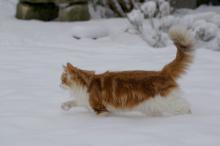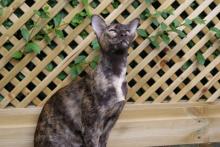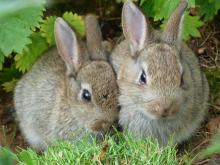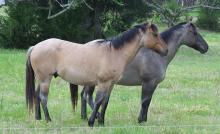Dilutions In Horses
Dilutions in horses "dilute" the base color of the horse making the horse appear lighter in color. Some, as with homozygous cream, can make the horse appear very nearly white. Some dilutions affect black pigment, other affect red and some affect both red and black pigment. A horse can carry and express more than one dilution and at times it can be difficult to distinguish different dilutions with similar expressions. The dilutions in horses are Cream, Dun, Champagne, Pearl and Silver
- Read more about Dilutions In Horses
- 5 comments
- Log in or register to post comments
Donkey Color Genetics
Donkey color genetics are not yet well understood, but are being researched more as breeding donkeys becomes more popular Also, with donkeys, "points" re
- Read more about Donkey Color Genetics
- Log in or register to post comments
Canine Coat Color Basics
Colors: Black, Yellow, and Red
Canines produce two types of pigment: eumelanin, which is black pigment; and phaeomelanin which is red/yellow pigment. It is the combination of these pigments, along with dilutions, modifiers, and white patterns, that make up the entire spectrum of dog coat colors.
In dogs and wolves there are four known alleles of the extension locus: EM, EG, E, and e. In the absence of dilutions or white patterns, a dog that is ee will be red or yellow. Its skin and eyes will still be dark, but the coat will only contain red or yellow pigment; thereby producing a red or yellow dog. In an ee dog, many other genes are masked. They are there, and will still be passed on to offspring, but they will not express. Dilutions and white patterns will still affect an ee dog.
- Read more about Canine Coat Color Basics
- 10 comments
- Log in or register to post comments
Adding to the basics: Dilutions and Modifiers in Dogs
There are many different dilution and modifier genes that can affect coat color (and sometimes skin pigmentation) in dogs. These include Brown (liver), Dilution (the D locus), Dilution of Red (Pheomelanin), Urajiro, Graying, and Merle.
How the Dog Got It's Spots...
During fetal development cells called melanocytes migrate out from the spinal cord to other areas of the body. These melanocytes produce the pigment that “colors†the dogs coat and skin. Areas where the melanocytes do not reach during fetal development remain without pigment causing areas of white hair and pink skin. The areas most commonly white in dogs are the last areas that are reached by the melanocytes: the chest, tip of the tail, and the toes. The current theory on white pattern development is that environmental factors in the womb (and perhaps white booster or suppressor genes) can affect melanocytes migration resulting in small white spots in these areas without an actual white pattern mutation. When mutations occur in the genes that control melanocyte migration, large areas of white can result. Recent studies have shown that at least one white pattern is the result of a mutation in the gene microphthalmia-associated transcription factor (MITF). However, this mutation does not account for all the white patterns found in canines and in some dogs the mutation does not follow the expected pattern indicating additional genes at work. (Schmutz et al. 2009)
- Read more about How the Dog Got It's Spots...
- 1 comment
- Log in or register to post comments
The Basics of Feline Color Genetics
Extension
As with all mammals, cats produce two types of pigment: eumelanin (black) and phaeomelanin (red/yellow).
- Read more about The Basics of Feline Color Genetics
- 4 comments
- Log in or register to post comments
Modifiers in Horses
Modifiers change the appearance of the horse coat color. They are similar to dilutions but have different effects.
- Read more about Modifiers in Horses
- 3 comments
- Log in or register to post comments
Dilutions and Modifiers of Coat Color in Cats
Cats exhibit a wide variety of coat colors, and as with all domestic animals, their colors are controlled by a variety of dilutions and modifiers.
White Patterns in Cats
At the present time there are at least three (3) white spotting patterns in cats.
- Read more about White Patterns in Cats
- Log in or register to post comments
White Patterns in Horses
Horses can have a great variety of white patterns. All of the following white patterns can occur on any color horse, with any combination of dilutions, modifiers, and other white patterns. For example, it is completely possible to have a tobiano/sabino/splash/roan/palomino. However, while it is possible, not all horse breeds carry all white patterns and dilutions, and possible does not equate to a likely outcome. All white patterns can also be present in minimal and maximal forms. Minimal can be very minimal indeed (think white spot on the bottom of a hoof for frame), and maximum expression can be almost completely white, especially when more than one pattern is present.
- Read more about White Patterns in Horses
- 1 comment
- Log in or register to post comments
Basic Rabbit Color Genetics: Extension and Agouti
Pictorial Guide to Horse Colors Part 1
- Read more about Pictorial Guide to Horse Colors Part 1
- Log in or register to post comments
Beginning Horse Color Genetics
All mammals produce two types of pigment, and horses are no exception. Eumelanin is black pigment and pheomelanin is red/yellow pigment. These two pigments work together to provide the basis of all horse colors. They are controlled by two genes, Extension (MCR1) and Agouti (ASIP).
- Read more about Beginning Horse Color Genetics
- Log in or register to post comments
